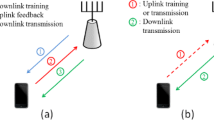Abstract
Thanks to the channel reciprocity, the time division duplex (TDD) operation is more preferred in massive multiple-input multiple-output (MIMO) systems. Avoiding the heavy feedback of downlink channel state information (CSI) from the user equipment (UE) to the base station (BS), the uplink CSI can be exploited for the downlink precoding. However, due to the mismatches of the radio frequency (RF) circuits at both sides of the link, the whole communication channels are usually not symmetric in practical systems. This paper is focused on the RF mismatches at the UEs and the BS for the multi-user massive MIMO systems with zero forcing (ZF) precoding. The closed-form expressions of the ergodic sum-rates are derived for evaluating the impact of RF mismatches on the system performance. Theoretical analysis and simulation results show that the RF mismatches at the UEs only lead to a negligible performance loss. However, it is imperative to perform reciprocity calibration at the BS, because the RF mismatches at the BS contribute to the inter-user interference (IUI) and result in a severe system performance degradation.
创新点
为了避免下行导频和用户反馈的开销 大规模MIMO系统利用TDD通信模式进行数据传输。这样根据上下行信道的互易性,基站可以利用上行信道信息来进行下行预编码的设计。然而收发两端射频电路增益的失配会破坏信道的互易性。基于迫零预编码,分别分析了基站端和用户端射频电路失配对系统性能的影响,得到可达和速率的闭式解。用户端的射频电路失配对系统性能的影响可以忽略,而基站端的射频电路失配会造成严重的用户间干扰,使得系统性能大大下降。
Similar content being viewed by others
References
Zhu H L. Performance comparison between distributed antenna and microcellular systems. IEEE J Sel Area Commun, 2011, 29: 1151–1163
Rusek F, Persson D, Lau B K, et al. Scaling up MIMO: opportunities and challenges with very large arrays. IEEE Signal Process Mag, 2013, 30: 40–60
Erik L, Edfors O, Tufvesson F, et al. Massive MIMO for next generation wireless systems. IEEE Commun Mag, 2014, 2: 186–195
Ma Z, Zhang Z, Ding Z, et al. Key techniques for 5G wireless communications: network architecture, physical layer, and MAC layer perspectives. Sci China Inf Sci, 2015, 58: 041301
Zhu H L, Wang J Z. Chunk-based resource allocation in OFDMA systems—Part I: chunk allocation. IEEE Trans Wirel Commun, 2009, 57: 2734–2744
Zhu H L, Wang J Z. Chunk-based resource allocation in OFDMA systems—Part II: joint chunk, power and bit allocation. IEEE Trans Wirel Commun, 2012, 60: 499–509
Zhu H L. Radio resource allocation for OFDMA systems in high speed environments. IEEE J Sel Area Commun, 2012, 30: 748–759
Huh H, Caire Giuseppe, Papadopoulos H C, et al. Achieving massive MIMO spectral efficiency with a not-so-large number of antennas. IEEE Trans Wirel Commun, 2011, 11: 3226–3239
Smith G S. A direct derivation of a single-antenna reciprocity relation for the time domain. IEEE Trans Antenn Propag, 2004, 52: 1568–1577
Hong Y, Marzetta T L. Performance of conjugate and zero-forcing beamforming in large-scale antenna systems. IEEE J Sel Area Commun, 2013, 31: 172–179
Bourdoux A. Non-reciprocal transceivers in OFDM/SDMA systems: impact and mitigation. In: Proceedings of IEEE Radio and Wireless Conference (RAWCON 03), Boston, 2003. 183–186
Kaltenberger F. Relative channel reciprocity calibration in MIMO/TDD systems. In: Proceedings of IEEE Future Network and Mobile Summit, Florence, 2010. 1–10
Huang F, Wang Y F, Yang J, et al. Antenna mismatch and calibration problem in coordinated multi-point transmission system. IET Commun, 2012, 6: 289–299
Wei H. ICD reciprocity calibration for distributed large-scale MIMO systems with BD precoding. In: Proceedings of IEEE International Conference on Communications in China (ICCC), Shenzhen, 2015. 1–5
Huawei. Hardware calibration requirement for dual layer beamforming. In: 3GPP TSG RAN WG1 Meeting #57, R1-092359, Los Angeles, 2009. 1–10
Ericsson. On the need for UE calibration for enhanced downlink transmission. In: 3GPP TSG RAN WG1 Meeting #57, R1-092016, San Francisco, 2009. 1–4
Alcatel-Lucent. Channel reciprocity modeling and performance evaluation. In: 3GPP TSG RAN WG1 Meeting #59, R1-100426, Jeju, 2010. 1–10
Wang D M, Wang J Z, You X H, et al. Spectral efficiency of distributed MIMO systems. IEEE J Sel Area Commun, 2013, 31: 2112–2127
Wang J Z, Zhu H L, Gomes N. Distributed antenna systems for mobile communications in high speed trains. IEEE J Sel Area Commun, 2012, 30: 675–683
Geng J. Antenna gain mismatch calibration for cooperative base stations. In: Proceedings of IEEE Vehicular Technology Conference (VTC-Fall), San Francisco, 2011. 1–5
Maiwald D, Kraus D. Calculation of moments of complex wishart and complex inverse wishart distributed matrices. IEE Proc-Radar Sonar Navig, 2000, 147: 162–168
Zhang Q T, Cui X W, Li X M. Very tight capacity bounds for MIMO-correlated rayleigh-fading channels. IEEE Trans Wirel Commun, 2005, 4: 681–688
Xing C W, Ma S D, Zhou Y Q. Matrix-monotonic optimization for MIMO systems. IEEE Trans Signal Process, 2015, 63: 334–348
Shepard C. Argos: practical many-antenna base stations. In: Proceedings of the 18th Annual International Conference on Mobile Computing and Networking, Istanbul, 2012. 53–64
Wei H, Wang D M, Zhu H L, et al. Mutual coupling calibration for multiuser massive MIMO systems. IEEE Trans Wirel Commun, 2015, doi: 10.1109/TWC.2015.2476467, in press. http://ieeexplore.ieee.org/xpls/abs all.jsp?arnumber =7239634
Author information
Authors and Affiliations
Corresponding author
Rights and permissions
About this article
Cite this article
Wei, H., Wang, D., Wang, J. et al. Impact of RF mismatches on the performance of massive MIMO systems with ZF precoding. Sci. China Inf. Sci. 59, 1–14 (2016). https://doi.org/10.1007/s11432-015-5509-1
Received:
Accepted:
Published:
Issue Date:
DOI: https://doi.org/10.1007/s11432-015-5509-1



